Despite being one of the strongest women’s teams on the African continent (having finished as Women’s Africa Cup of Nations (WAFCON) runners-up five times and been champions once), South Africa have never been that successful when it comes to the world stage — 2019 is their only previous appearance and it lasted just three matches as they finished bottom of their group.
As such, they will be hoping to improve on that result when this year’s action gets underway. Despite being drawn into a tough group that sees them meet Sweden, Argentina and Italy, there is optimism that getting points on the board might not be beyond them. Their squad is undoubtedly capable of securing them, with some very exciting players on their books who have been in strong form of late, and even drawing a game would be an improvement on four years ago and would demonstrate that South Africa are moving in the right direction.
In order to see how possible that target could be though, this tactical analysis will look at every aspect of Banyana Banyana’s play, picking out their key tactics, identifying the players who will make a difference for them on the field and providing a prediction for how far they could end up going.
Predicted Starting XI
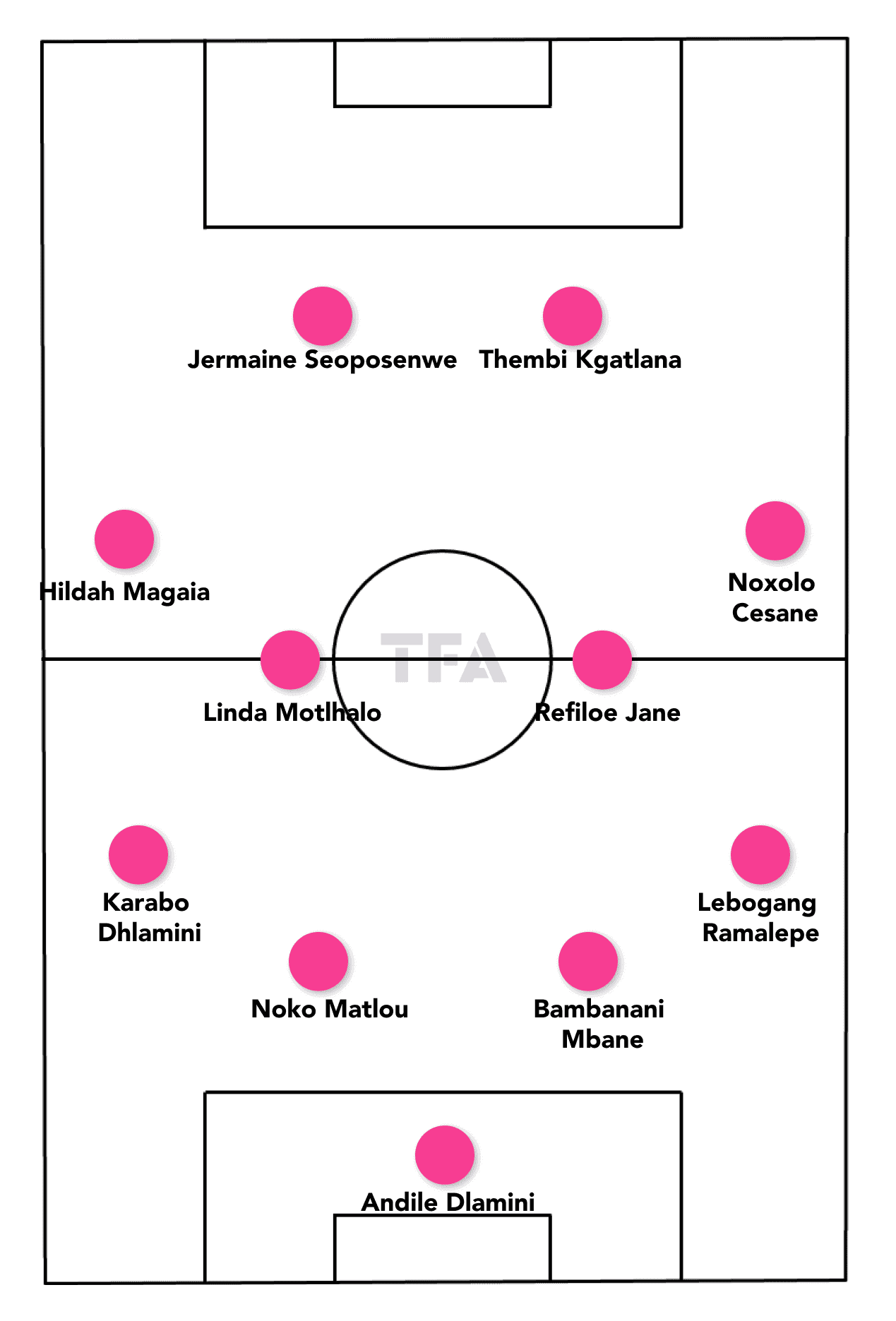
South Africa have tended to favour a 4-4-2 setup under long-serving head coach Desiree Ellis, who has been in charge since 2016, and so it seems very likely that she will once again rely on the 4-4-2 shape when the action gets underway as it gives her the necessary balance around the team that she is constantly striving for.
In goal, it is likely that Mamelodi Sundowns Ladies’ Andile Dlamini will be given the nod, with her featuring in the vast majority of South Africa’s games, although it should be mentioned that Ellis has included four goalkeepers in her squad and so there is the possibility that she might rotate between Dlamini, JVW’s Kaylin Swart, UWC’s Regirl Ngobeni and Bloemfontein Celtic’s Kebotseng Moletsane.
The defensive line is also fairly set in stone, with Ellis seeming to prefer a back four consisting of Dinamo Minsk’s Lebohang Ramalepe, centre-backs Bambanani Mbane and Noko Matlou of Mamelodi and Eibar Femenino respectively and another Sundowns player in left-back Karabo Dhlamini, and the fact that they play together so often means that partnerships have evolved and knowledge of each other’s strengths and weaknesses has been developed over time.
The midfield four is less straightforward because there have been fluctuations in Ellis’ selection, and it was certainly the case during last year’s WAFCON tournament that players were shifted around to cover key absences. However, when everyone is fit, the central midfield is likely to be made up of Sassuolo Femminile’s Refiloe Jane and Glasgow City’s Linda Motlhalo, as that ensures that they can both break up opposing attacks and create opportunities further forward. Outside them, it is likely that Noxolo Cesane and Hildah Magaia of UANL Tigres Femenil and Sejong Sportstoto Women, respectively, will start.
At the top of the field, Juárez Femenil’s Jermaine Seoposenwe is a regular fixture in the side, and it is likely that she will be joined by the once again-fit Thembi Kgatlana, who suffered a serious injury during a group game against Botswana during the 2022 WAFCON tournament, but who is back firing on all cylinders for Racing Louisville in the NWSL.
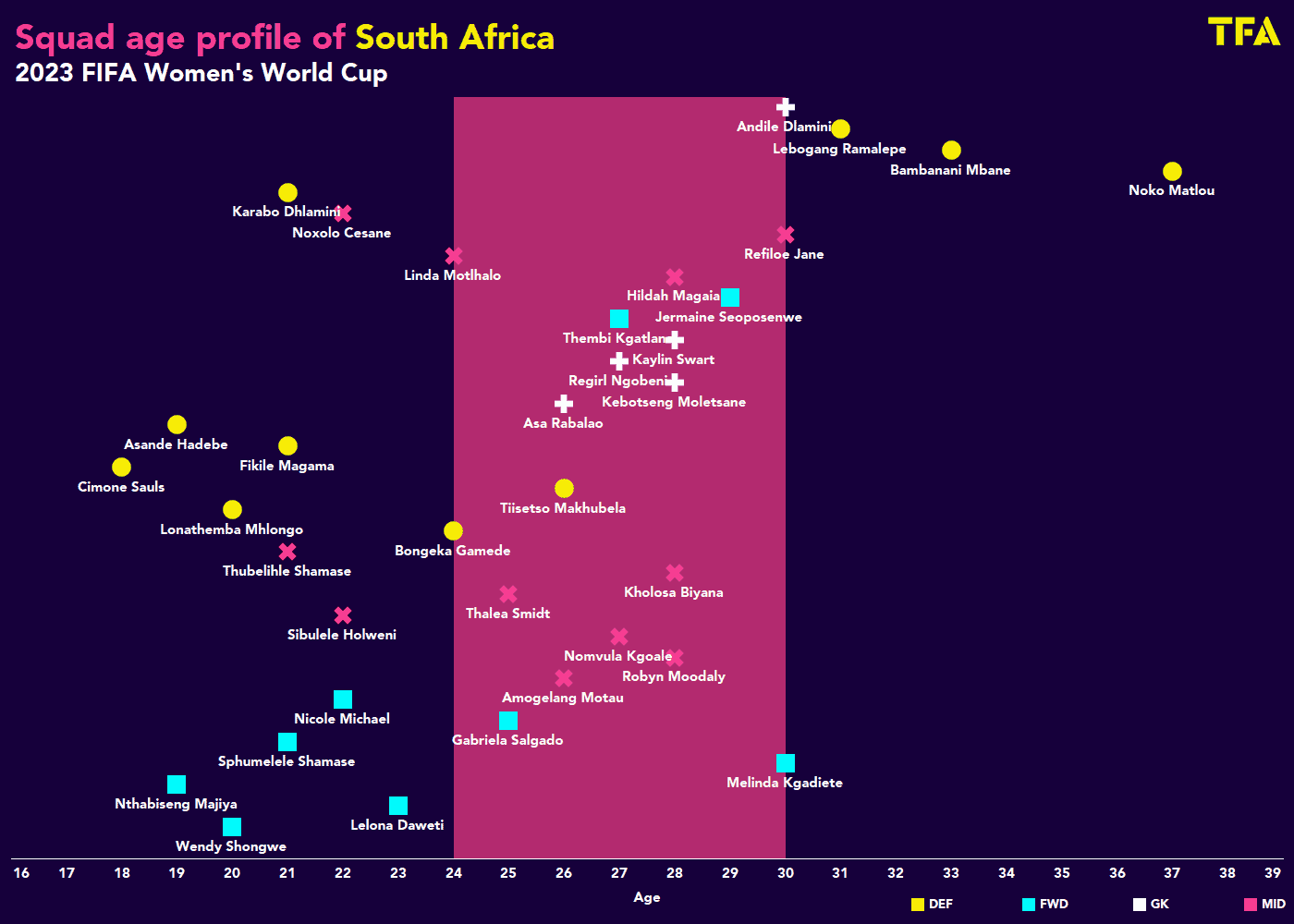
It is interesting when looking at the spread of ages in the South African team to see that Banyana Banyana prefer players who are either at the beginning of their international careers or who are at their peak, with there being few names included in their squad who are over the age of 30, and that perhaps suggests that Ellis is looking towards the next generation as a way of sustaining South Africa’s growth and development and is also keen to build partnerships and combinations that will last for years to come.
However, experience should never be knocked, and the fact that they have players in their backline who are in the latter stages of their careers means that they can fall back on them when under pressure and know that they will understand what is needed to deal with different situations, which could be key given the attacking quality of all three of South African’s upcoming opponents.
Attacking Phase
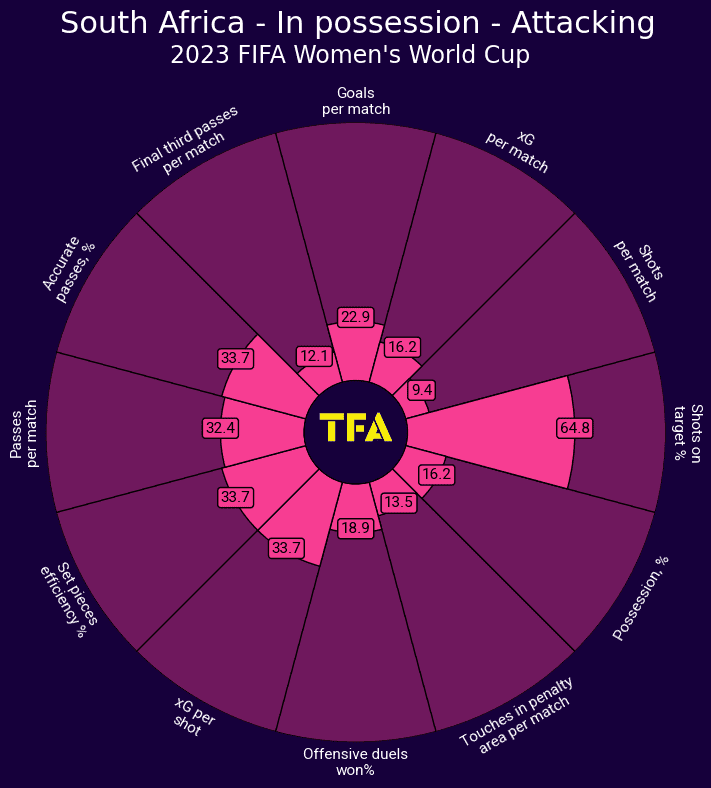
When looking at South Africa’s attacking play, what becomes immediately clear from this graphic is that they are not the strongest team inside the final third when compared to others at the tournament. However, given that they are yet to really establish themselves in the way that others always have, that is to be expected.
There are signs though of what they are trying to do and evidence that they cannot be taken for granted, with them ranking highly in percentile terms for the percentage of their shots that they get on target, so even though they are not a side expected to thrive at the top of the field, they will test their opponents and defences will have to remain alert whenever they do get onto the front foot.
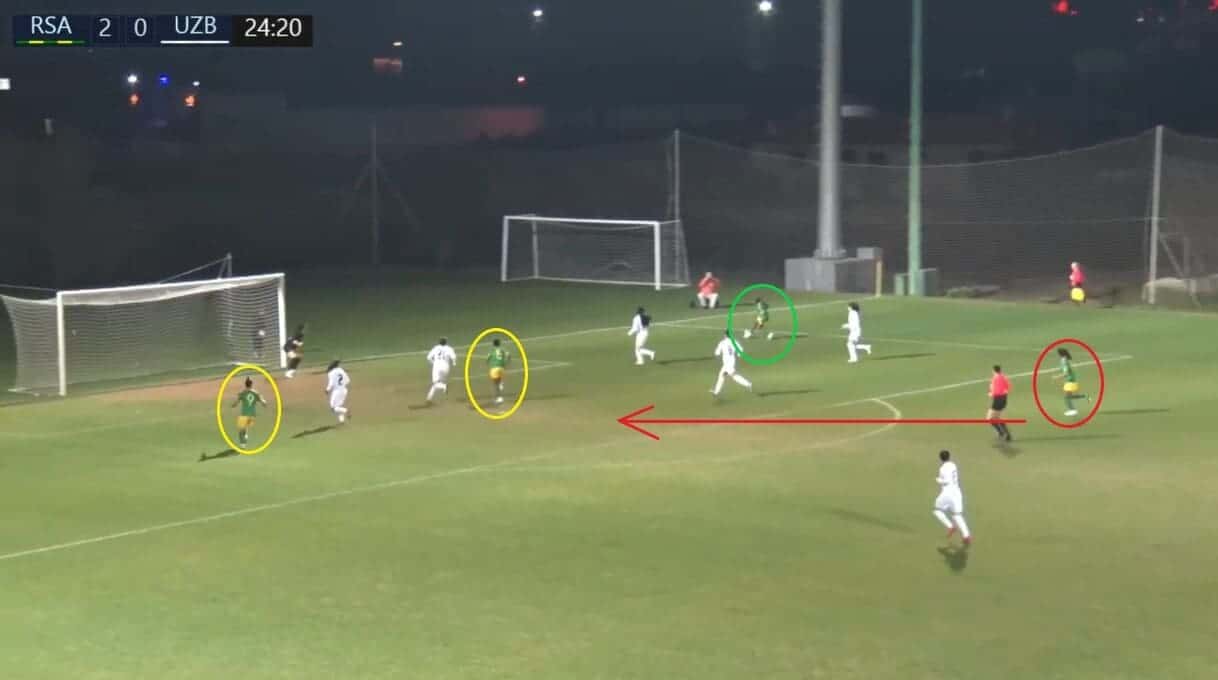
The thing that helps South Africa to have such a strong percentage of shots on target is that they always play cautiously and are happy to take additional steps where needed to ensure that opportunities do not end prematurely. This means that balls are often played out towards the wings before then being pulled back into the middle, meaning that the overall accuracy of their play is high and opponents do not have chances to win back possession too easily. Situations like this are common as a result, in that the ball will be on the edge of the goal area and players will be waiting in the middle for it to be passed into their vicinity.
However, in this case, there is an added feature to South Africa’s play, and it shows a development on the idea as they use that basic tactic to manipulate defences into leaving spaces open. To explain, Uzbekistan are aware, here, of what Ellis’ team are looking to do and so are marking both Magaia and JVW striker Gabriela Salgado tightly. But those two players have no intention of receiving the pass here. Instead, their focus is on keeping the Uzbekistani defence pinned back and leaving the gap open behind them.
With everything in place, Cesane can now pass into the hole towards the top of the goal area and Seoposenwe can make a delayed run to get on the end of it before shooting at goal. Regardless of whether chances like these are converted or not, the fact that South Africa are continually evolving and building on the basic principles of their play is a huge positive for them, and it will give them a greater chance of scoring goals and improving on their 2019 display.
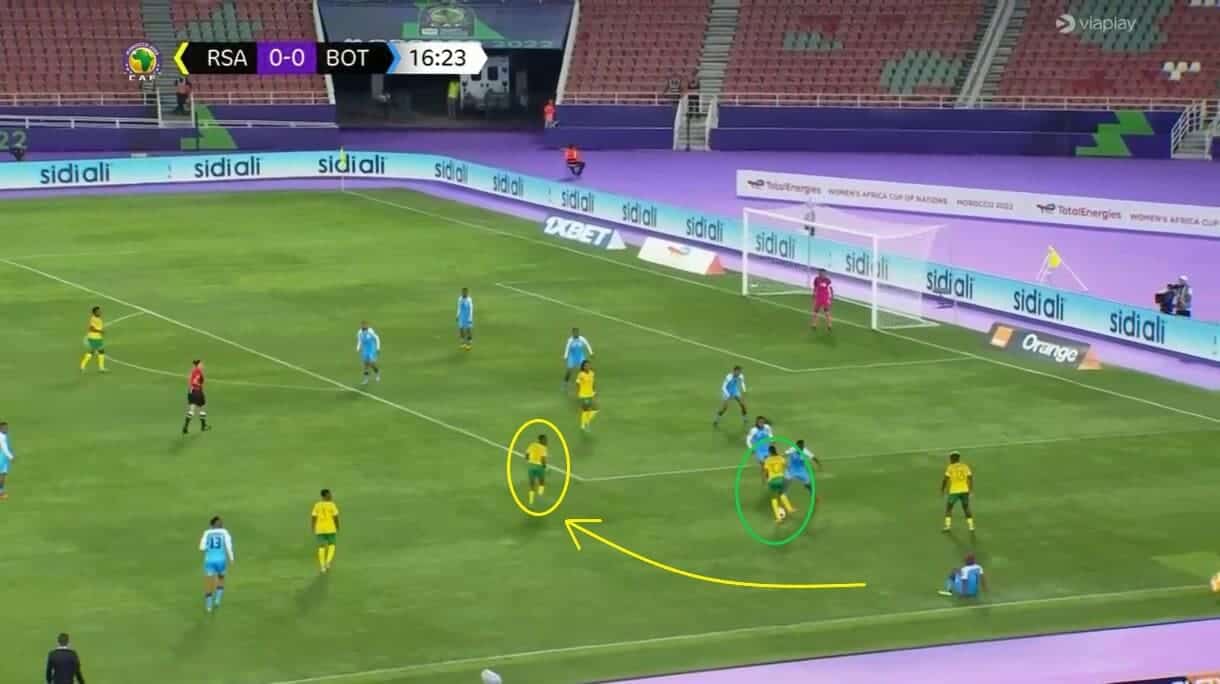
It has been mentioned that a lot of South Africa’s strengths lie in different player combinations, and one that really stands out as central to everything that they do well is the link-up between Motlhalo and Kgatlana. Time and time again, and regardless of where on the field they are playing, they will be seen in the same area of the field as each other, and the pace and creativity that both possess means that, once they have the ball, they are really difficult for opponents to contain.
In this case, the ball is once again on the wings, with Motlhalo, who can play as a winger if needed, coming across to get on the ball and play her part in keeping the attack alive. However, with her now unable to progress any further infield due to Botswana getting tight to the ball, she needs an option to be created for her, and that is where Kgatlana comes in. As the arrow indicates, she makes a curved run behind the Glasgow player and allows the ball to be passed into the half-spaces. From there, Kgatlana can exploit some of the interior gaps in the defensive line and shoot at goal.
The understanding that these two players have is almost telepathic at times; there is little doubt that South Africa always play better when both are on the field, so getting them on the ball as frequently as possible will be key to South Africa providing a significant test for their opponents.
Defensive Phase
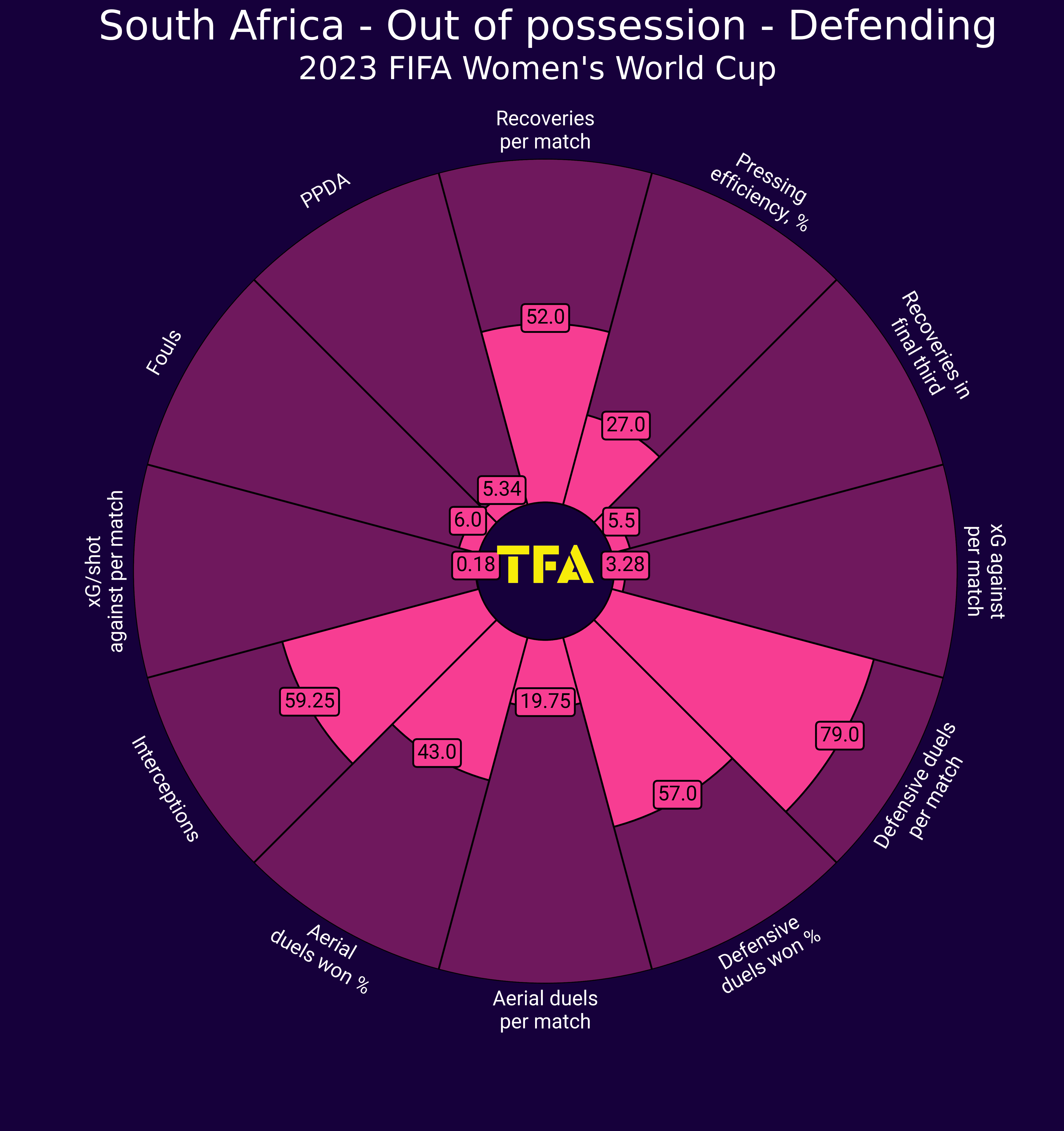
With them not having especially high rankings for the attacking side of things, some people might expect them to be more successful without the ball as they try to convert a negative into a positive. There are several areas that South Africa are exemplary — they like to engage in defensive duels and fight for balls, whilst the fact that they make plenty of interceptions also shows how they don’t allow teams much time to gather their thoughts when moving the ball up the field and constantly look to win back possession as soon as they can.
However, what will worry fans is that they don’t have an especially high pressing efficiency in percentile terms, with them falling well below the average for that statistic, which shows how, whilst they have the desire to win balls and to put pressure on their opponents, they are let down by not executing their press correctly.
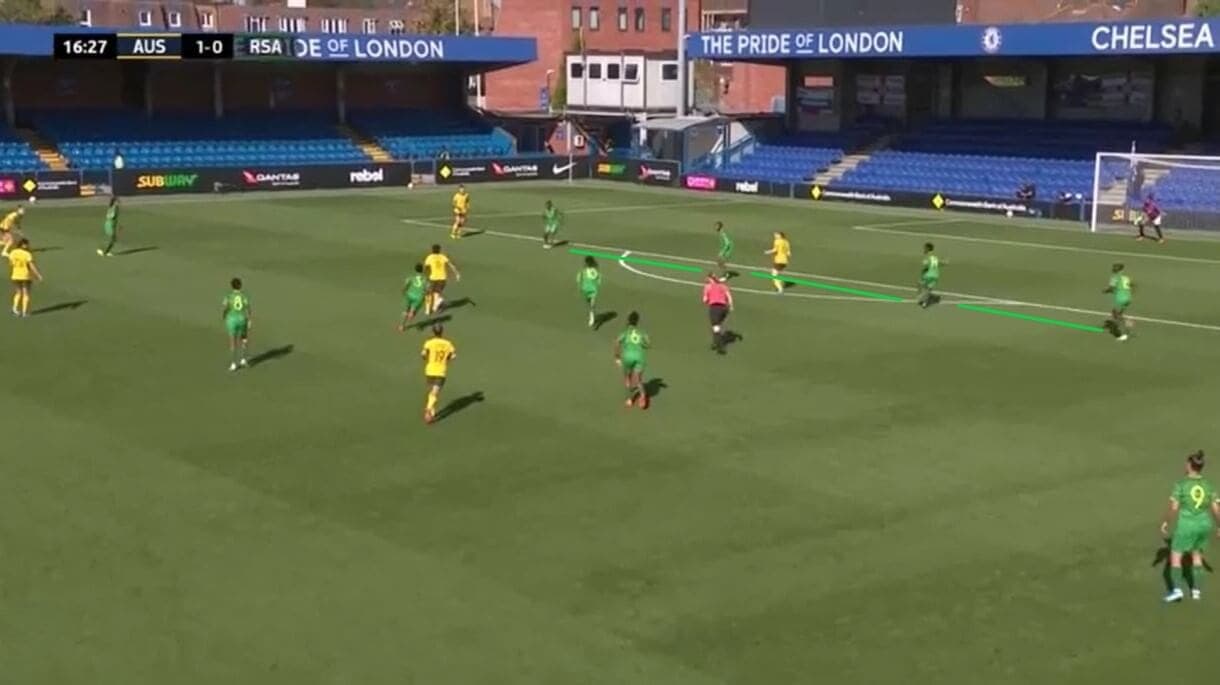
As a result, situations like this are common whenever South Africa lose the ball, with Australia in this case getting into their third and looking to find a way through the defensive line and through to goal. Banyana Banyana do have a solid back four structure that looks evenly spread out here, showing the organisation and understanding of roles that has already been mentioned in the scout report as something that Ellis’ team have the ability to fall back on in moments such as this.
However, where this goes wrong is when they look to press the ball, as is common whenever the ball arrives in these positions. What usually ends up happening is that they don’t make strong enough contact with it in order to divert its path significantly enough. As a result, the pass from Manchester City Women’s Mary Fowler, despite being deflected, ends up at the feet of her former clubmate Hayley Raso in the space behind the defensive line, leading to a shot on goal.
On this occasion, South Africa were able to get back and block Raso’s effort. They were let off by the offside flag being eventually raised, but the fact that this was not a one-off means that they need to work on how they deal with situations like this, because other opponents may be more clinical and the officials may not come to their rescue next time.
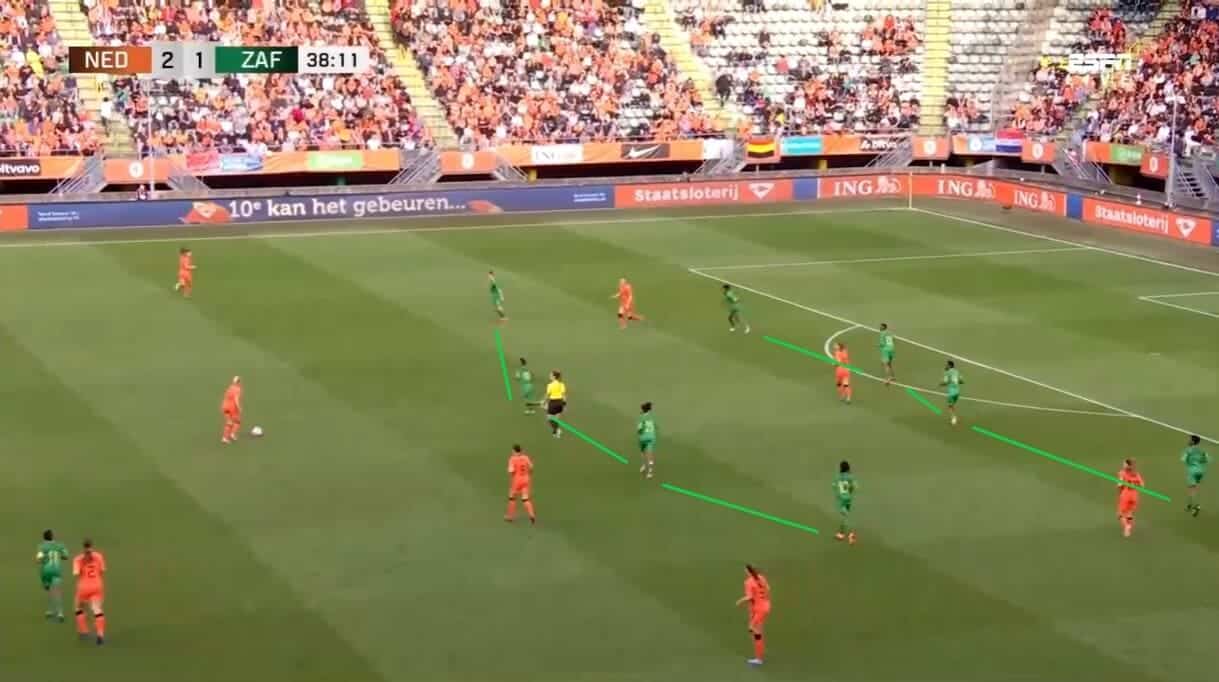
This fragility is perhaps why they do sometimes opt for two lines behind the ball as they try to create a low block and put even more distance between the ball and their goal.
However, again, there are issues with the way that they set up here, in that the spaces are too great between the lines and the Netherlands could get key players like Arsenal Women duo Vivianne Miedema and Victoria Pelova into those areas. As a result, rather than being forced to look for an alternative way around the South African players, PSG Féminine midfielder Jackie Groenen was able to simply feed the ball through to Miedema, who then linked up with Pelova before having a shot on goal.
As with the previous example, what this shows is that South Africa have good ideas when it comes to how they want to play without the ball, but the execution is often left wanting, and that is why some of the statistics in the graphic at the beginning of this section were so high.
Transitions
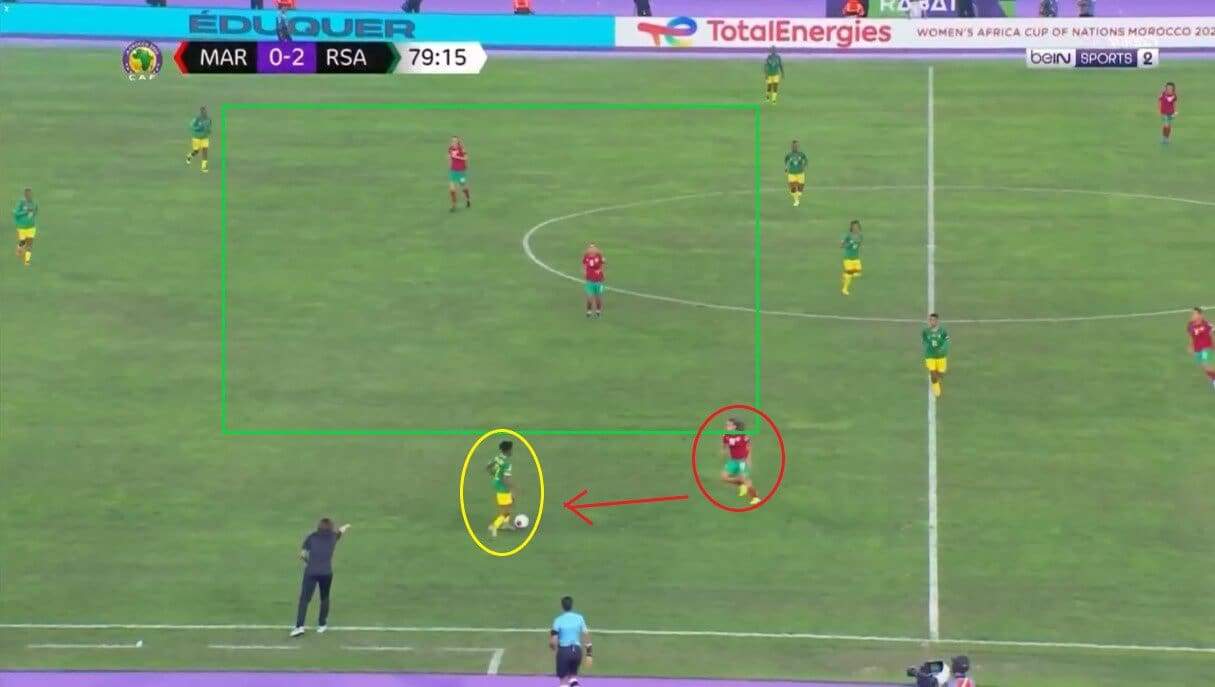
When they don’t have time to get players behind the ball, things are even more difficult for them, and quick transitions by opponents do often catch them out. In this case, during the latter stages of the WAFCON final last year, Ramalepe gives the ball to Morocco forward Fatima Tagnaout and invites the North Africans to push forward and put the back line under pressure, and Morocco are a team that don’t need a second invitation in moments like this and they often take full advantage of opposing errors.
Once Tagnaout won the ball here, she was able to link up with Ibtissam Jraïdi and set up Tottenham Hotspur Women forward Rosella Ayane to tap into the back of the net, and it was a goal that came entirely as a result of South Africa being far too casual when playing out from the back.
With Banyana Banyana constantly pushing players forward to aid their attacks, they need the back four to be careful in moments like this, because the gap between them and the midfield is often significant. Therefore, if the ball is given away, there is little chance that help will arrive in time. This goal didn’t matter in the end, as it came late on in the final and was only a consolation as things panned out, but the situation could be very different in the World Cup and it could be the difference between progression and going home.
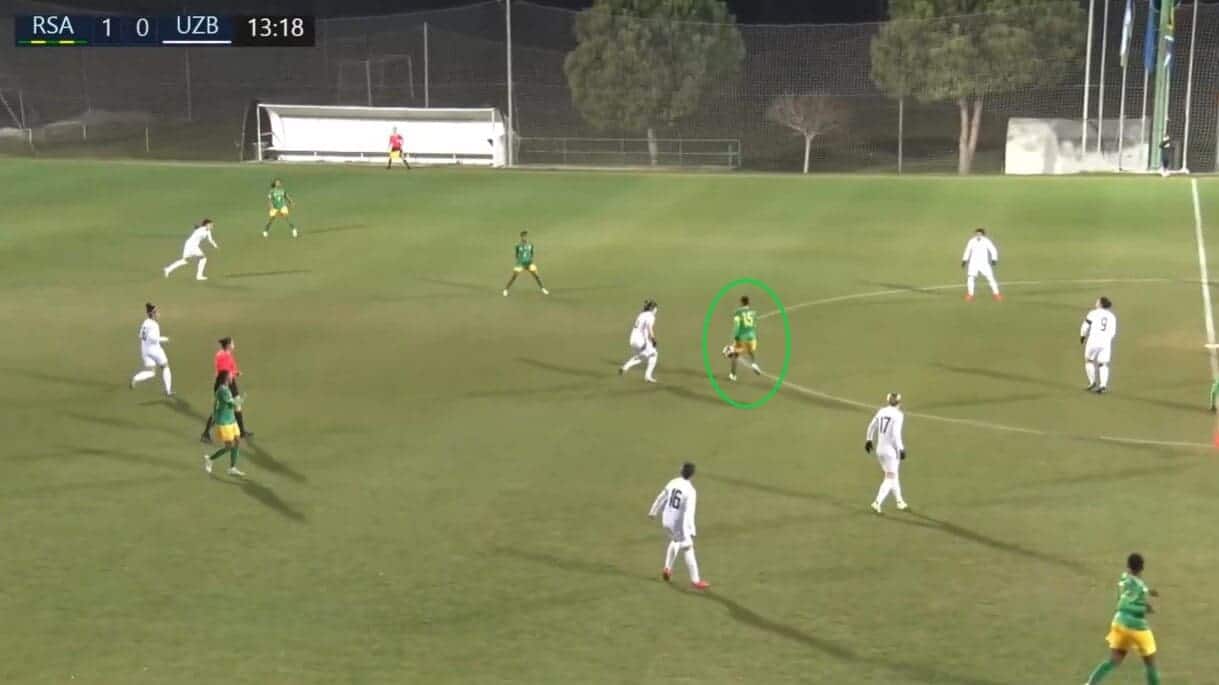
Their defence-to-attack transitions do provide more positive viewing though, and their ability to win the ball and instantly get on the front foot comes through the presence of one particular player, which is Jane.
It was mentioned in the first section of the analysis that South Africa have a good balance in the midfield with her and Motlhalo in the centre of the field, and Motlhalo’s attacking play has already been looked at. However, Jane is much more of a deep-lying distributor and is someone who can very ably disrupt opposing phases and intercept passes at will; her presence is one of the key reasons that South Africa are above the average for interceptions made in the earlier graphic.
She also has a really good passing range, which was demonstrated in full in this game largely through Uzbekistan’s reluctance to push forward, but the fact that she reads the game well and rarely makes a mistake with her passes shows that she is an important player for Banyana Banyana and will be someone that they will be relying on to steady the ship whenever opponents try to counterattack against them.
Defenders
What is clear when looking at South Africa’s squad is that the vast majority of them feature for clubs in their homeland, meaning that a lot of them will be fairly unknown to those fans who don’t often watch the Super League.
However, even when just looking at the ages of those who are likely to come on as substitutes during matches, what is clear is that Ellis has chosen players who are young and who will be part of the team for many years to come.
As much as she has a preference for experienced players in the defensive line, she is always looking to bring on the next generation of players and to ensure that there is a constant cycle of player progression and team development to ensure that the team can maintain the momentum that they are hoping to build.
Midfielders
As mentioned, though, the midfielders who tend to start games are in their peak years, so there is not the same difference in ages as there is in the defensive line. Instead, it comes down to qualities and which player combinations work that dictates who starts and who is left on the bench. The fact that Ellis has been known to rotate in the central third means that the likes of Sibulele Holweni, who can double up as a left-back if needed, Kholosa Biyana, Nomvula Kgoale and Robyn Moodaly could all make appearances during the tournament.
However, whether they start or not will depend on the approach that Ellis wants to take to each game, and what has been clear is that she won’t hesitate to swap players in or out if she feels that that is what is best for the team.
Attackers
It is much the same story in the forward line, with players capable of alternating into it and moving around as needed; the fact that Magaia operated as a striker during Kgatlana’s absence last year and does play at the top of the field for her club side at times shows that, again, there are options and things to consider when it comes to their lineup for each game.
As with the defensive unit, there are also clearly some younger players that Ellis is eyeing up for the future that have been included in the party heading down under, such as 22-year-old Nicole Michael, 21-year-old Sphumelele Shamase and 19-year-old Nthabiseng Majiya, so it is clear that, again, Ellis is not only thinking about the now but also the future, and developing new talent ready for when those ahead of them hang up their boots. It will be interesting to see if they are given chances to play at the World Cup and where Ellis feels that they can have an impact.
Key Player
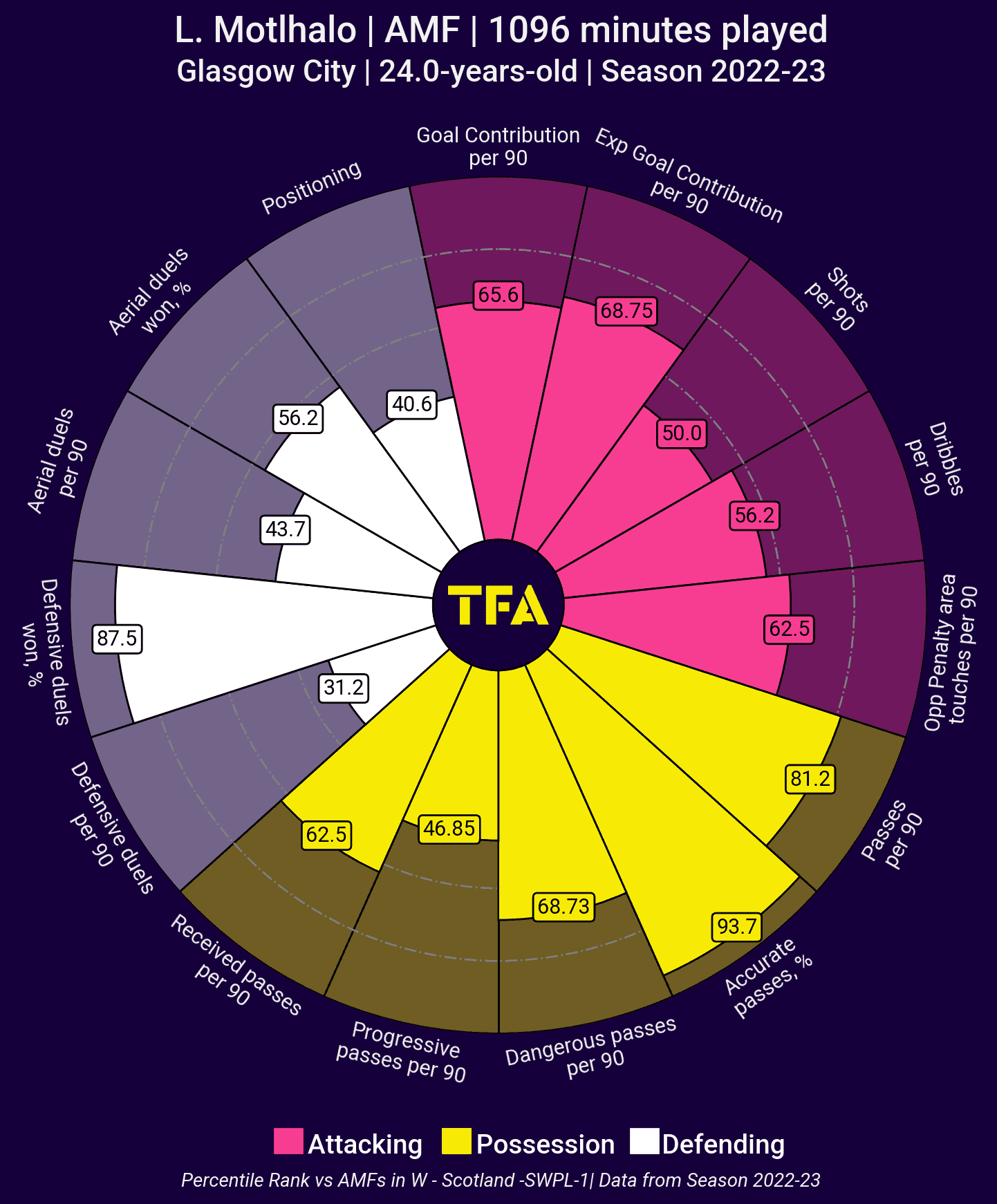
Given that, as mentioned, South Africa like to play on the front foot as much as possible and commit numbers forward whenever they can, it makes sense to select a player to watch who is a key part of that offensive play, and the name that has constantly stood out in the scout report is Motlhalo. So much of what Banyana Banyana do well comes through her eye for a pass, shooting ability and link-up play, and it is worth remembering that she is still just 24 years old, so has a long way to go in her career, meaning that further improvements are very possible and will only serve to increase the excitement around her.
With Kgatlana’s injury last year, she needed to shoulder additional responsibilities for her team, and it was something that she really took to, which demonstrated why she is such a dependable player and why Glasgow opted to sign her from Djurgårdens in January on their way to regaining the SWPL 1 crown, which was sealed on a pulsating final day of action that could have seen the title go to any of Glasgow, Celtic Women or Rangers Women. She has the mentality of a winner, and her statistics here reflect how vital she is both for club and country.
Tournament Prediction
South Africa are undoubtedly one of the best teams in Africa, and their record in WAFCON tournaments of reaching the latter stages cannot be underplayed. However, this will be the year that they will hope to take that positivity and show they can compete with the best in the world. The quality of their squad should excite both their own fans and those who just enjoy watching the tournament unfold.
They have been placed in a group that contains Sweden, Argentina and Italy, and whilst no one is expecting them to take anything from the first of those, the latter two could present opportunities to claim points that eluded them four years ago — especially since Italy showed at Euro 2022 that they have tournaments when they don’t turn up and make themselves easy to beat.
All in all, though, if they were to end up third in their group and to leave having secured either a draw or a win, then that will be a step forward in their development and would have allowed them to demonstrate that they do belong at the top table of the international women’s game, so it would not be a result to be extremely disappointed about.

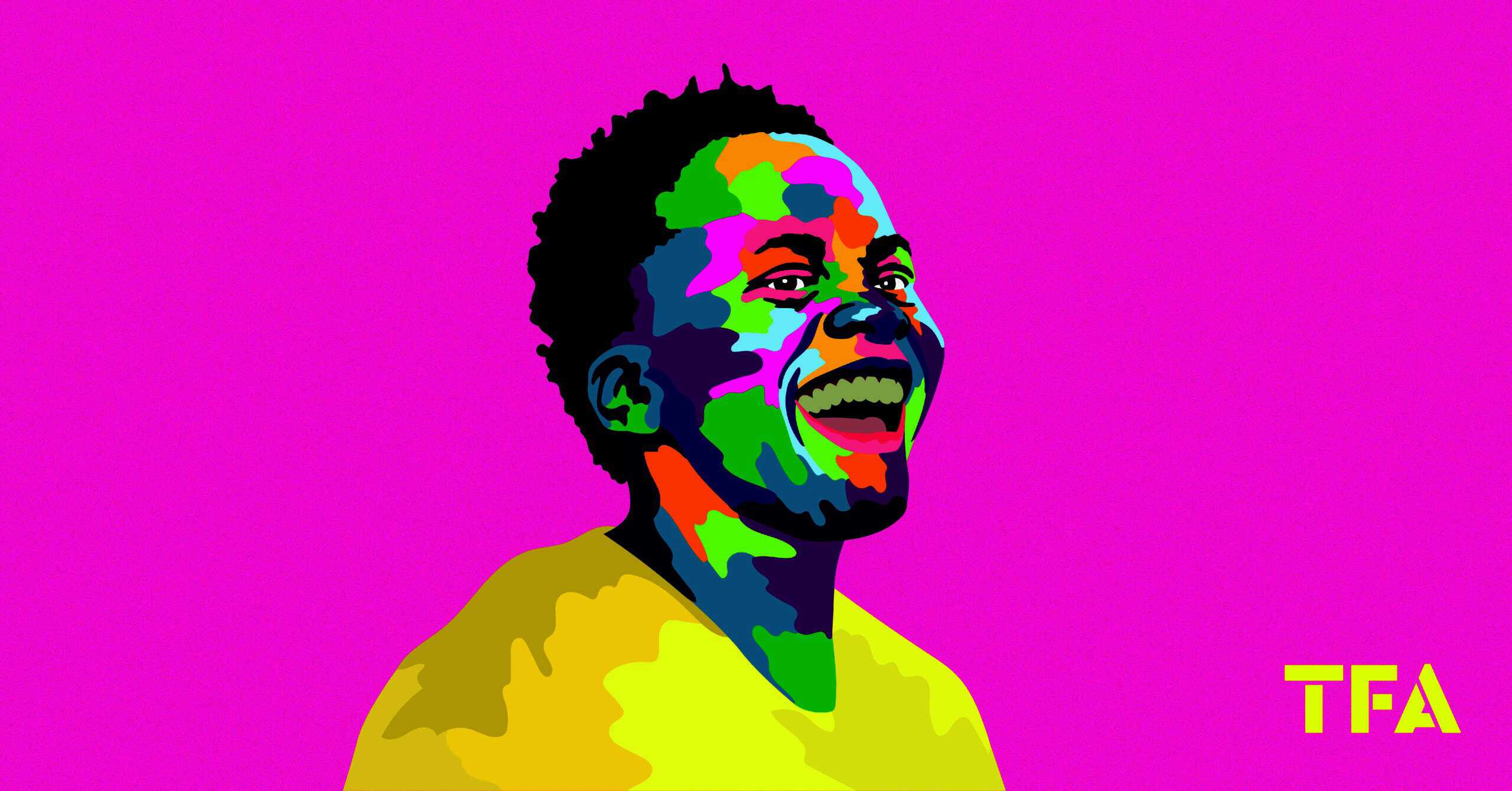



Comments